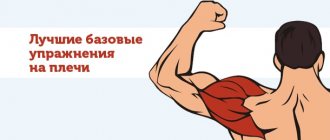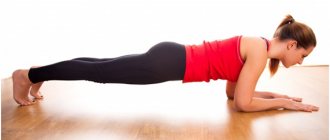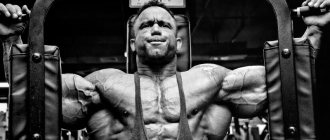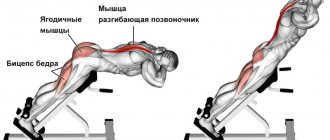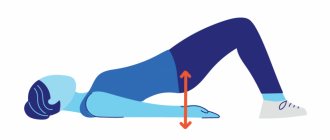Hyperextension for the back is an effective exercise that many athletes use to develop the posterior muscles of the back and hips. It helps strengthen the lower back muscles and tighten certain abdominal muscles. According to statistics, girls use hyperextension much more often than men. This is explained by what muscles the exercise develops.
It is necessary to strictly adhere to the basic rules of execution, since there are many execution techniques. To understand how to perform them correctly, you should familiarize yourself with the basic technique or take a training course from a qualified trainer.
What muscles are trained?
When performing hyperextension, a large number of muscles are involved. Do not assume that only the gluteal muscle is trained. First of all, the short back muscles, which cannot be developed with other exercises, and the back of the thighs are involved. The back of the thigh includes the following muscles:
- biceps – located on the lateral (outer) side of the back of the thigh;
- semitendinosus – located on the inner side of the back of the thigh;
- semimembranosus - located on the inside of the back of the thigh, under the semitendinosus muscle.
When training the buttocks and lower legs, the calf and gluteus maximus muscles are used.
Indications and benefits
The main load of the whole body lies on the lumbar back, which is why it is so important to have a well-developed muscle corset. It is the spine that is responsible for the vital functions of the body, protects the spinal cord and internal organs, and also ensures normal movement and balance support. Therefore, with underdeveloped muscles, a person develops various pathologies and diseases of the musculoskeletal system. At this moment, a person’s physical training plays a big role.
In addition to training the posterior muscles of the back and hips, hyperextension is prescribed in the following cases:
- To relieve muscle pain in the lumbar region. In this case, a person should perform hyperextension in combination with abdominal exercises. Training the entire muscle corset will increase blood flow and relieve pain.
- As a warm-up part to slowly stretch and prepare muscles for further stress. This exercise is good for warming up before lifting heavy weights.
- To support muscle tone. Hyperextension improves overall blood flow to the lower back and improves the tone of the muscles being worked.
- Strengthening the muscle tissue around the spine. Skeletal muscles play an important role in maintaining balance.
- Prevention of diffuse degenerative diseases of the spine. This exercise helps prevent many back pathologies caused by impaired metabolism.
- Posture regulation. It is hyperextension that helps strengthen those back muscles that are responsible for correct posture.
Many athletes believe that this exercise only helps strengthen the muscle corset. In fact, hyperextension helps you lose weight and increase muscle mass. The only contraindication to training is the presence of chronic spinal diseases during an exacerbation. To identify contraindications, a person must first consult with a doctor and obtain permission to perform.
Hyperextension is well suited for people with a curved spinal column, lordosis, kyphosis and scoliosis
How to treat a hernia in the lumbar region?
In medicine, there are two methods of getting rid of a hernia - conservative and surgical. The surgical method involves performing a surgical operation if the conservative method does not help the patient.
Conservative methods can use drug and non-drug treatment. Usually both practices are used in combination.
This article does not cover treatment with medications. Non-drug methods involve undergoing various physiotherapeutic procedures, such as acupuncture, manual therapy, hirudotherapy, as well as physical therapy. Let's look at the last point in more detail.
Therapeutic gymnastics is a set of special exercises, the purpose of which is to restore the condition of the spine and strengthen the muscle corset around it. For each specific case associated with a similar disease, the neurologist compiles a separate complex.
Regular exercise will help you get rid of lower back pain
It is not recommended to self-medicate even at this level, that is, inventing some exercises on your own. This is extremely dangerous to health. Such frivolity can lead to deterioration and serious complications, some of which may be irreversible.
Proper execution
Many newcomers to the sport are concerned about how to properly do hyperextension and other equally important exercises. This question will be answered by qualified athletes and bodybuilders with many years of experience. When performing this exercise, keep the following points in mind. Correct posture. Round back hyperextension is considered an incorrect and ineffective training method. When performing, the back should be straight and the tailbone should look back.
You should not lower your body as low as possible and lift it as high as possible, as this increases the load on your back, in particular, on the erector spinal muscles. This is not correct. For enhanced training of the gluteal muscle and the back of the thigh, it is recommended to position the pelvis so that it is in the air, and the middle of the thighs rests on the pad of the machine.
It is necessary to lower the body as you inhale, and raise the body as you exhale. This will help improve blood flow to muscle tissue. The trainer is quite simple to use. If it is difficult for a beginner to figure it out on his own, then it is better to seek the help of a qualified specialist or an experienced athlete.
Back massage mat with needles
From the very beginning, you need to adjust the machine so that the rollers are located in the crook of your lower back. The lower rollers, in turn, should be slightly above the heel tendon. As soon as a person is on the machine, he needs to put his feet behind the lower roller. This will provide him with reliable support and protection from falling.
The back should be straight so that together with the legs it forms one straight line. In this position, the person is ready to begin execution. After the starting position, the person must tense the gluteal muscle and lower the body down, bending the lower back.
You should not bend low, as you can damage or strain your muscles. At the moment of lowering the body, the back should be straight. At the bottom it may be slightly curved. After tilting, you should raise your body up to the starting position. At the moment of lowering and raising, your arms should be crossed over your chest. Each point (lower and upper) must be fixed for 2-3 seconds.
In the first month, the torso should be tilted at an angle of no more than 60°. The lower the degree, the more load is placed on the buttocks and thighs
How to replace hyperextension at home
If performing hyperextension at home is problematic, you can select a number of exercises for the same muscle groups, namely the hamstrings, gluteal, and lumbar extensors.
- The simplest option is a gluteal bridge on the floor; if desired, you can place any available weighting material on the pelvic area.
- In this case, if you have a barbell or dumbbells, you can perform a deadlift; the main thing is to keep your back straight, because now the load on the spine increases significantly.
- You can also perform bends with a barbell while standing, with the barbell placed on your shoulders.
- Another option at home can be considered squats, although the exercise works the lower back and hamstrings to a lesser extent, but there is a load on the quadriceps muscles of the thigh, and the abdominal muscles also act as stabilizers in the exercise.
Basic mistakes
When performing the exercise, you need to know which movements can lead to pain or stretching of muscle tissue. In this case, you should not go down too far, as this stretches the erector spinal muscles and does not in any way affect the problem areas of the back. If a person tries to correct the curvature, then he will not achieve the desired result in this way.
The next mistake is lifting too high. With such a rise, a large deflection of the body appears, as a result of which the back and legs do not form one straight line. The human body should also not rapidly oscillate from bottom to top, like a pendulum. A novice athlete should remember that the whole body must be tense throughout the entire exercise. This applies to bending your knees and swinging your arms. Hands need to be fixed in one position (crossed on the chest).
The most common mistake is lifting heavy weights in the first classes. The unprepared body of beginners is unadapted to such loads, so the lower back may not withstand the exercise. For the first month, professional athletes recommend hyperextension without excess load. Only after precisely honed movements can you proceed to light weights.
Rodeo
This exercise is the highlight of this article. It will leave absolutely no one indifferent. First of all, it trains balance and perfectly lifts your mood. Of the muscle groups, the abs and stabilizers are perfectly loaded. The essence of the exercise is simple - you need to sit astride the ball and remain a fitball rider for as long as possible.
There are several options for implementation. We will offer two of them. The simplest is the one that involves squatting on a fitball as on a regular chair.
- Sit on the ball.
- Lift your legs off the floor, straightening them at the knee joints.
- When balancing in this position, maintain your balance as much as possible.
Actively engage your abdominal muscles. Spread your arms out to the sides. As soon as you relax your abs, you will immediately lose your balance.
A slightly more difficult option is to sit astride your knees.
- Go to the fitball.
- Leaning towards the ball, rest your hands on it and alternately place your knee joints on it.
- Straighten your body and remove your hands from the ball.
- Maintain your balance as much as you can.
Try to place your feet as close to the edges of the fitball as possible - this is the most optimal support position for this exercise.
Conclusion
Training with a fitball has a beneficial effect on the vestibular system, develops coordination and gives many positive emotions. All this also has a positive effect on metabolism. With the help of a fitball, you can warm up and also get quite a serious load. Today, such balls can be purchased at almost any sports equipment store. Make the most of the opportunities for your own development and expand your fitness horizons. The more varied your training, the more results you will achieve later.
Editor and proofreader: Farida Seidova
Are you training at home? Then you might also be interested in these articles:
Classification
The correct technique is the classic form of this exercise. But there is also a simpler technique that is great for beginner athletes. It's called "reverse hyperextension." Unlike the classic form, in reverse hyperextension the body is fixed, and the muscles are trained by raising the legs. Due to this change in fixation, the exercise is considered safer for the spinal column.
In reverse hyperextension, the muscular corset maintains balance, and the arms are involved in supporting the whole body
The main load falls on the back muscles of the thighs and the gluteus maximus muscle. In addition to this type, there is another type of exercise. This technique does not use one of the legs; it hangs in the air and is not used in any way during the workout. The basic technique remains the same, so this type does not cause any difficulties for athletes.
Plank
Doing planks on a fitball will give you a lot of excitement, believe me. Unstable ball support will stress your abs and stabilizer muscles so much that it will not seem like much. Everyone who does a plank on a fitball for the first time remembers this day for a long time. Therefore, if you have been practicing the classic version on the floor for a long time, you should switch to a fitball, thereby increasing your level.
This exercise can be performed in several variations, which include different positions of the hands as support. Let's consider the most classic option on the elbows.
- Place your arms bent at the elbows on the ball.
- Stepping back, bring yourself into a plank position.
- Don't shake (just kidding).
Perform 4 sets of 60 seconds.
In any version of the plank, do not allow excessive bending in the lumbar area!
Try to keep your lower back level relative to your entire body.
When leaning on a fitball, your arms should be strictly perpendicular to the floor.
The closer your elbows are to each other, the more difficult it will be to maintain balance. Therefore, if you are just getting acquainted with this variation of this exercise, place your elbows as far as possible from the center of the fitball. In the future, gradually reduce the distance between your elbows, thereby increasing the load on the stabilizer muscles.
Experiment.
